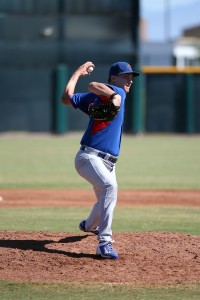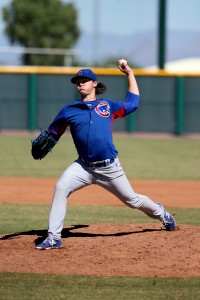Feature Photo: Carson Sands, LHP, Cubs
The Cubs’ 2014 draft class has a chance to be one of their best in recent history. After selecting Kyle Schwarber in the first round and signing him for an under slot bonus, Chicago was able to reallocate much of the saved money to the middle rounds where they inked three top high school arms in Carson Sands (fourth round), Justin Steele (fifth round), and Dylan Cease (sixth round). While Cease has the highest ceiling of the prospect trio, the Cubs have high hopes for Sands and Steele, as well, and the comparative merits of the two make for an interesting debate.

Carson Sands, LHP, Cubs
On the surface, there are a lot of similarities between Sands and Steele. They are both left-handed pitchers. They were selected one round apart with very similar signing bonuses – Sands in the fourth round and signing for $1.1 million; Steele in the fifth and signing for an even $1 million. Both are roughly the same age and pitched at the same level of competition last year. Even their fastball velocity is similar, with both pitchers sitting around 93 mph and able to reach a tick or two higher on occasion. Both offer an above-average curve as their best secondary pitch.
Yet, there are also fundamental differences between Sands and Steele in terms of size, delivery, and approach. I’ve seen both pitchers frequently and find myself oscillating in preference. A quick survey around the industry showed no consensus, as scouts seemed almost equally divided between the two.
Below I share some observations about these talented lefties, which I hope will help move us closer to answering this question: Who will have the better major league career, Carson Sands or Justin Steele?

Carson Sands, LHP, Cubs
Carson Sands, LHP, Eugene (Short-Season A, Cubs)
Ht/Wt: 6’3″/205 | B/T: L/L| Age (as of 1/1/2016): 20y, 9m
Sands has a big, strong 6-foot-3 frame, pitching out of a three-quarters arm slot with good downward plane. The delivery is clean, simple and balanced, with a good line towards home plate. His mechanics are easily repeatable and give Sands a chance to throw strikes consistently as he continues to accumulate reps and gain experience.
The strong build is certainly an advantage for the lefty, and should fit in nicely with a Cubs’ rotation that currently averages about 6-foot-4, 225 pounds (hinting at an organizational preference for starting pitchers with good size). Sands should eventually fill out to something close to that and with the clean delivery, good plane, and potential to throw strikes, many see him as the kind of pitcher who can work efficiently and eat up innings.
In addition to his physical attributes and easy delivery, Sands routinely impresses with his repertoire. He generates 92 to 94 mph velocity without a lot of effort and the curve flashes above-average. One of Sands’s biggest strengths is his feel for pitching and in particular, his changeup, which projects as an above-average offering. In total, Sands profiles as a durable lefty who throws strikes with the potential for three above-average offerings – a welcome projection in any system.
Perhaps the most interesting aspect of his profile, however, is his pitchability. While he does not yet have that one big out pitch, he knows how to use his entire arsenal, showing comfort with all three offerings and regularly keeping hitters off balance while limiting hard contact.
Sands is not flashy but he is one of the better all-around pitching prospects in the Cubs’ organization, and that gives him a chance to move quickly. Right now he profiles as a solid number four starter in a major league rotation with a chance to be a mid-rotation workhorse if the curve develops into a more consistent out pitch.

Justin Steele, LHP, Cubs
Justin Steele, LHP, Eugene (Short-Season A, Cubs)
Ht/Wt: 6’2″/195 | B/T: L/L| Age (as of 1/1/2016): 20y, 5m
Steele also pitches from a three-quarters arm slot, but possesses a slighter frame than Sands. While he doesn’t create the same downhill plane as Sands, Steele shows a bit more arm speed to go with a bit more deception. The arm action is clean and shorter out front, with a slight hitch in his motion as he enters his high leg lift. This action can disrupt a hitter’s timing while helping Steele to hide the ball, making him tough to pick-up.
While the fastball velocity is similar to Sands, it grades out a half-grade or so higher than Sands, as Steele’s heater tends to draw more frequent empty swings. The curve has good shape and depth and already flashes above-average. Still, there is room to grow the pitch further thanks to the arm speed, with the offering showing plus potential down the line. The changeup lags a bit behind the fastball and curve right now, but shows the makings of at least an average offering, as well.
One differentiating factor between the profiles of Sands and Steele is the superior athleticism of the latter. The delivery isn’t as simple as Sands, yet Steele shows the ability to repeat his mechanics every bit as well. His athletic acumen is also observable off the mound, with Steele showing himself to be a pretty good hitter and defender when given the opportunity.
Lastly, while “deception” pitchers often get slapped with the “finesse pitcher” stigma, nothing could be further from the truth in Steele’s case. Evaluators rave about his tough, bulldog mentality on the mound, and any observer will note how aggressively he goes after hitters, attacking the strike zone and showing lots of confidence in his fastball/curve combo.
The slighter build and still-developing changeup have some scouts pegging Steele as a reliever, and if that comes to pass his ability to miss bats would play well there. But I believe he continues to have a good chance to stick as a starter, with the athleticism and clean arm action helping to make up for the lack of size and build we have seen in Cubs starting pitchers of late.
* * * * *
At this stage there is no right or wrong answer, which is part of the fun of this exercise. So, who you got? Sands or Steele?
[yop_poll id=”3″]


